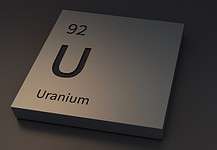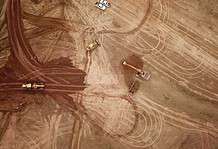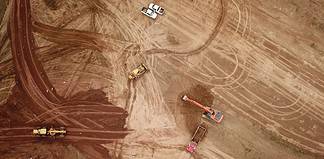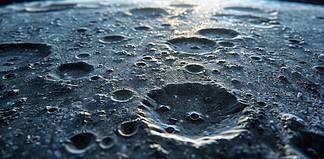The Goonyella Riverside Mine is a large open cut coking coal mine in the Bowen Basin, located near Moranbah.
It’s one of seven owned and operated by the BHP Mitsubishi Alliance (a joint partnership comprising BHP Billiton and Mitsubishi Corporation), making BMA the largest coal exporter in Australia, and the largest supplier of seaborne coking coal in the world.
The company exports more than 55mt of coal annually to over 27 countries.
The product is transported by rail to the coal export terminals at Dalrymple Bay and Hay Point, from where it is exported to the customers in India, China, South Korea, Latin America and Europe.
Goonyella is a reasonably large mine, taking 30-40 minutes to drive from one end to the other, and is made up of continuous pits.
The Goonyella Upper Seam, the Goonyella Middle Seam and the Goonyella Lower Seam are all mined at the site, with the coal well-known for its excellent coking characteristics.
First mined in 1971, Goonyella was developed by Central Queensland Coal Associates before being sold to BHP.
It merged with the adjacent Riverside open cut mine in 1989 but the Riverside deposit became depleted in 2005.
In reserve
The Goonyella coal mine was estimated to hold 549mt of recoverable coal reserves, including 530mt of proved and 19mt of probable ore reserves, as of June 2019.
The open-pit mine was also estimated to contain 784mt of measured and 32mt of indicated coal resources.
It produced 17.1mt of metallurgical coal in the year ending June 30, 2019, compared to 15.9mt in 2018.
Extraction
Once the coal seam is exposed, it is drilled and blasted.
Mining is then carried out with the use of front end loaders and hydraulic shovels, with excavators used to minimise the need for blasting.
Historically, the raw coal has been taken from the pit with a fleet of bottom dump trucks and rear dump trucks, which haul the coal from between 16km and 30km, depending on the face being worked at the time.
A satellite-based tracking and monitoring system is used to manage the coal mining fleet, which includes Marion 8050, BE 1370 and BE 1350 draglines, Cat 994 front end loaders, Terex O&K RH 170 and Liebherr R 9800 excavators, P&H4100XPB and P&H4100A shovels, Cat 784 bottom dump trucks, as well as Cat 793 and Komatsu 930 E rear dump trucks.
The run-of-the-mine (ROM) coal is blended at the coal preparation plant and crushed to less than 50mm.
Beneficiation separates the different grades, and the final product is taken to either Dalrymple Bay or Hay Point coal terminals by an electric railway system on trains consisting of 120 wagons that can pull more than 9000t with each load.
Bulk carriers of 200,000t capacity take the coal to its final destination.
Automation
In November 2019, BMA announced plans to introduce an automatic haulage system at the mine by the second half of 2020.
BMA asset president James Palmer said haul trucks at Goonyella would be fitted with autonomous vehicle technology, allowing the completion of an extensive study and engagement with the workforce, community and all levels of government.
The introduction of autonomous haulage will involve the staged conversion to an autonomous fleet of up to 86 Komatsu trucks.
It will build on the mine’s strong production record by increasing truck hours and delivering more consistent cycle times.
“Autonomous haulage will help us improve safety and productivity performance, and it is our people who will be at the centre of making this change a success,” Mr Palmer said.
“While the first autonomous vehicles will not operate at the site until late 2020, and full roll-out will take around two years, we want to give people in our workforce and the community as much notice as possible of this change.”
According to BMA, there will be no forced employee redundancies at Goonyella from the move.
In fact, Mr Palmer said with the recent recruitment of permanent positions in BHP Operations Services and the creation of roles through autonomous haulage, overall permanent job numbers across BMA operations would increase.
He said BMA’s long-term commitment to the region was underpinned by a responsibility to provide training opportunities for local workers to ensure they had access to the skills and capabilities to succeed in the future of mining.
“This move represents a multi-generational investment by BMA in the future of the Bowen Basin,” he said.
As BMA’s first site to implement autonomous haulage, Mr Palmer said talks were held with the workforce and the local community for several months leading up to the decision.
“We understand that automation represents a significant change,” he said. “It also offers a unique opportunity for people to gain new, highly valued skills.”
To help prepare for Goonyella’s autonomous future, it is estimated more than 40,000 hours of training were and will be delivered, ranging from general awareness to extensive training for those operating equipment, interacting with the autonomous haul trucks or taking on new roles.
“No further decisions have been made to implement autonomous haulage at any other site,” Mr Palmer said.
“Any future decisions to implement autonomous haulage will be made on a site-by-site basis.”
Business impact
The move to automation has been a boost for the local economy, with more than 30 regional business in Central Queensland supporting the preparatory work for the rollout.
These contracts amount to over $4.2m out of the planned $8.2m spend.
Goonyella general manager Sean Milfull said the local businesses have upskilled their staff, and in some cases have employed several new staff to support the works being completed at the mine ahead of the first trucks being operational from September this year. “Autonomous haulage will help us further improve safety and productivity on site, and we are creating new roles and opportunities for the people of Central Queensland,” he said.
Mackay-based NB Industries is completing the fit-out of ancillary equipment, a critical piece of work that enables equipment to be visible and communicate via the autonomous system.
“This type of work is generally done by OEMs so it is a great example of a local business demonstrating their capacity to support autonomous work,” Mr Milfull said.
“NB Industries have employed three new full time tradesmen to support the work. They are in addition to their roster of eight full time tradesmen.”
The business has also had to use additional labour for some short term works during the rollout, increasing the team as required at times.
The work NB Industries is completing requires a mixtures of auto electrical, communications and boiler maker trades.
As these tradesman are all working together, they are learning skills from each other and some of them have even expressed interest in completing a dual trade.
NB Industries business development manager Simon Plant said the project has afforded the opportunity to employ more local talent, upskill and enhance the experience of the existing workforce and foster multiskilled tradespeople.
“Due to the shortage of skilled tradespeople in our sector, we are passionate about investing in training and mentoring to grow the resourcefulness and relevance of our team and community into the future,” he said.
“NB Industries is 100% Qld-owned and operated, employs local labour and supports local and Qld companies through our local community and our supply chains.”
Another beneficiary of the automation is Moranbah-based CPH Mining & Civil, which built the new ramp 25 calibration pad and access road.
The new Komatsu autonomous haulage trucks will have their autonomy functionality tested on the calibration pad before entering the pit to be commissioned.
CPH Mining & Civil owner Colin Ritson said it had been fantastic supporting Goonyella as the mine prepares for autonomous trucks.
“This project has been a great opportunity for the business and for our people,” he said.
Simply excellent
The move to automated haulage comes as the Queensland Government provided $3.6m in funding for a Resources Centre of Excellence (RCOE), to be built in Mackay, about two hours away from Goonyella.
Two key components of the Resources Centre of Excellence are:
- An Underground Mining Simulated Training Facility (UMSTF)
- An integrated approach to bringing together the various resources related training and research facilities and services currently available in the region.
With the Mackay-Isaac-Whitsunday region home to 34 operating coal mines, the sector is one of the largest Mining Equipment, Technology and Services (METS) hubs in Australia.
The RCOE will be an important nexus between research, education and the resources industry, allowing the region to capture value from the significant expertise that currently exists there.
The Resources Centre of Excellence is expected to be a collaborative partnership that brings together the current and proposed facilities in the region including, but not limited to Central Queensland University’s (CQU) Engineering Trade Training Facility; CQU’s Robotics and Mechatronics Facility; the Health and Safety Centre; and various Registered Training Organisations.
The UMSTF is proposed to be the physical centre for the RCOE and is based off a Brisbane facility that was previously owned and operated by a local listed mining services company.










































